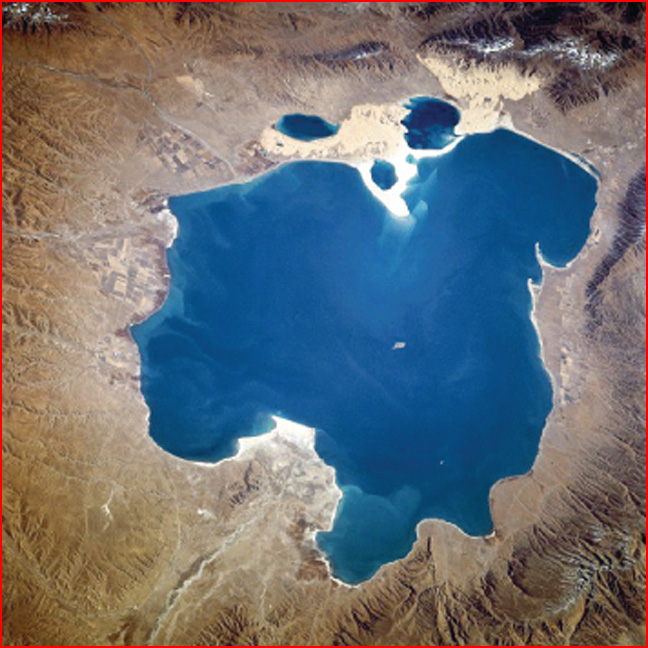
home •
about •
essential guide •
picture of the day •
thunderblogs •
news •
multimedia •
predictions •
products •
get involved •
contact
picture of the day archive subject index
Qinghai Lake one of the largest salt-water lakes in the world. Credit: NASA/USGS
Nov 09, 2007
China's Mysterious Iron Pipes
A large number of strange iron cylinders and rusted scraps of iron have been found in western China. Could they be evidence of electrical activity?In a previous Thunderbolts Picture of the Day, we discussed the bizarre "stone eggs" found in China, as well as many other places around the world. We noted in one instance that the sandstone nodules from the Utah desert are often encased in iron shells. In our contemplation of Martian geology, based on the information gleaned from the Mars Exploration Rover B, iron oxide and silicon dioxide have been discovered intimately bound up together in almost every sample taken.
Ripples and "dunes" of hematite extend for hundreds of kilometers in conjunction with silicon dioxide "pavement" or "cobbles" - flat, etched slabs of white stone with regular polygonal cracks in the structure. The iron oxide ripples lie on top of the stone blocks.
The Electric Universe theory may help to explain the strange formations found everywhere we look on Earth. In the case of stone spheres that have been uncovered in the U.S., Asia and Australia, it appears as if they were "condensed" out of the surrounding mineral deposits. Lightning discharges striking the Earth and traveling through the strata just below the surface may have created the stone nodules through compression forces. In plasma physics, such compression zones are called "z-pinches."
As electricity travels through plasma (some stone could be considered a form of solid plasma), it begins to spin in a helical pattern. Two strands of energy will twist around one another gradually coming closer together because of "long-range attraction." But due to short-range repulsion", never touching. The twin channels of current flow ultimately come close enough that the space between them is magnetically crushed into a tiny volume. Any substances between the twisted pairs of plasma will also be crushed into spherules of varying sizes, depending on the strength of the discharge.
China's stone spheres, those from Bosnia and Costa Rica, as well as other places, are probably the remains of those electric currents forming z-pinch nodules like grapes on the vine. But what about the trackway of the electricity through the stone and soil - the "stems" that hold the grapes? Could the "iron pipes" from Mongolia and elsewhere be the signs of such an event?
In 2002 a group of Chinese archaeologists investigated a cave on Mt. Baigong in the Qinghai province of Tibet. Located on the Qinghai-Tibet Plateau at over 3600 meters, Mt. Baigong is noted for a "pyramid" standing on its summit. Although archaeologists and anthropologists have not adequately studied the pyramid, its general appearance is one of natural forces at work and not man-made. It is irregular and exhibits no stonework or tool marks. One of the most interesting findings there are the iron pipes scattered in rusty broken bits around the terrain.
A small cave within the pyramid reveals dozens of the pipes embedded in the floor and angling out of the walls. They range in size from 10 centimeters up to 40 centimeters. They are reddish-brown and closely resemble the color of the surrounding rocks. On the shore of Lake Toson, additional cylinders are found, some as small as a toothpick. None of the cylinders are filled with debris or hardened sediments despite being reported as very old.
China is not the only place where such rusted iron cylinders are located. There are "Louisiana cylinders" from an area near a gigantic salt dome just south of New Orleans and "Navajo pipes" from the same region in Utah as sandstone "Moqui marbles." Could the cylinders be the stems on which the "stone grapes" grew?
Electricity forms hollow tubes as they penetrate a charged substance like plasma. The spinning Birkeland currents are charge sheaths that have folded around into a vortex, creating a double-layer that carries electric current. These "tubes" of electricity may have left behind the mark of their passing by transmuting the silicon dioxide of Mt. Baigong (and the Navajo sandstone formation) into the coarse, oxidized cylinders of hematite that have so confounded scientists. In fact, the Baigong pipes contain up to 30% silicon dioxide in their matrix.
By Stephen Smith
___________________________________________________________________________Please visit our Forum
The Electric Sky and The Electric Universe available now!

|
|

|
EXECUTIVE EDITORS:
David Talbott, Wallace Thornhill
MANAGING EDITORS:
Steve Smith, Mel Acheson
CONTRIBUTING EDITORS: Michael Armstrong, Dwardu Cardona,
Ev Cochrane,
C.J. Ransom, Don Scott, Rens van der Sluijs, Ian Tresman
WEBMASTER: Brian Talbott
Copyright 2007: thunderbolts.info
![]()
home •
thunderblogs •
forum •
picture of the day •
resources •
team •
updates •
contact us

